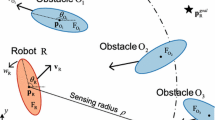Abstract
This paper describes a method for estimating the distance between a robot and its surrounding environment using best ellipsoid fit. The method consists of the following two stages. First we approximate the detailed geometry of the robot and its environment by minimum-volume enclosing ellipsoids. The computation of these ellipsoids is a convex optimization problem, for which efficient algorithms are known. Then we compute a conservative distance estimate using an important but little known formula for the distance of a point from and n-dimensional ellipse. The computation of the distance estimate (and its gradient vector) is shown to be an eigenvalue problem, whose solution can be rapidly found using standard techniques. We also present an incremental version of the distance computation, which takes place along a continuous trajectory taken by the robot. We have implemented the proposed approach and present some preliminary results.
Similar content being viewed by others
References
Baraff, D.: Curved surfaces and coherence for nonpenetrating rigid body simulation, Computer Graphics (Proc. SIGGRAPH) 24(4) (1990), 19–28.
Bobrow, J. E.: A direct minimization approach for obtaining the distance between convex polyhedra, International Journal of Robotics Research 8(3) (1989), 65–76.
Canny, J. F.: Collision detection for moving polyhedra, IEEE Transactions on PAMI 8(1986), 200–209.
Choset, H. and Burdick, J. W.: Sensor based planning, Part ii: Incremental construction of the generalized voronoi graph, in: IEEE Int. Conference on robotics and Automation, Nagoya, Japan, 1995, pp. 1643–1649.
Clarke, F. H.: Optimization and Nonsmooth Analysis, SIAM Publications, 1990.
Dobkin, D. P. and Kirpatrick, D. G.: Fast detection of polyhedral intersection, Theoretical Computer Science 27(1983), 241–253.
Donald, B. R.: Motion planning with six degrees of freedom, Research Report AI-TR-791, Artificial Intelligence Lab., MIT, 1984.
Faverjon, B.: Hierarchical object models for efficient anti-collision algorithms, in: IEEE Int. Conference on Robotics and Automation, Scottsdale, AZ, 1989, pp. 333–340.
Fleming, W.: Functions of Several Variables, Springer-Verlag, New York, 1987.
Flynn, P. J. and Jain, A. K.: CAD-based computer vision–from CAD models to relational graphs, IEEE Transactions on PAMI 13(2) (1991), 114–132.
Gander, W.: Least squares with a quadratic constraint, Numerische Mathematik 36(1981), 291–307.
Gander, W., Golub, G. H., and Matt, U.: A constrained eigenvalue problem, Linear Algebra and Its Applications, 1989, pp. 815–839.
Gilbert, E. G., Johnson, D. W., and Keerthi, S. S.: A fast procedure for computing the distance between objects in three-dimensional space, IEEE Transactions on Robotics and Automation 4(1988), 193–203.
Grotschel, M., Lovasz, L., and Schrijver, A.: Geometric Algorithms and Combinatorial Optimization, Springer-Verlag, New York, 1988.
Henrich, D. and Cheng, X.: Fast distance computation for on-line collision detection with multi-arm robots, in: IEEE Int. Conference on Robotics and Automation, Nice, France, 1992, pp. 2514–2519.
Hubbard, P.: Interactive collision detection, in: IEEE Symposium on Research Frontiers in Virtual Reality, 1993, pp. 24–31.
John, F.: Extremum problems with inequalities as subsidiary conditions (1948), in: J. Moser (ed.), Fritz John Collected Papers,Ch. 2, Birkhauser, Boston, 1985, pp. 543–560.
Kalvin, A. D. and Taylor, R. H.: Superfaces: Polyhedral approximation with bounded error, in: SPIE Conference on Medical Imaging, Vol. 2164, Newport Beach, CA, 1994, pp. 1–13.
Khatib, O.: Real time obstacle avoidance for manipulators and mobile robots, International Journal of Robotics Research 5(1) (1986), 90–99.
Knopp, K.: Theory of Functions II, Dover, New York, 1947.
Lin, M. C. and Canny, J. F.: An opportunistic global path planner, in: IEEE Int. Conference on Robotics and Automation, Cincinnati, OH, 1990, pp. 1554–1558.
Lin, M. C. and Canny, J. F.: A fast algorithm for incremental distance calculation, in: IEEE Int. Conference on Robotics and Automation, Sacramento, CA, 1991, pp. 1008–1014.
Lozano-Pérez, T.: Spatial planning: A configuration space approach, IEEE Transactions on Computers 32(2) (1983), 108–120.
Martin, R. R. and Stephenson, P. C.: Containment algorithm for objects in rectangular boxes, in: Theory and Practice of Geometric Modeling, Springer-Verlag, New York, 1989, pp. 307–325.
Nesterov, Y. E. and Nemirovsky, A. S.: Interior Point Polynomial Methods in Convex Programming: Theory and Applications, Springer-Verlag, New York, 1992.
Pentland, A. P.: Perceptual organization and the representation of natural form, in: Readings in Computer Vision, Kaufmann, Los Altos, CA, 1987, pp. 680–699.
Post, M. J.: Minimum spanning ellipsoids, in: ACM Symposium on Theory of Computing, Washington, DC, 1984, pp. 108–116.
Press, W. H., Flannery, B. P., Teukolsky, S. A., and Vetterling, W. T.: Numerical Recipes in C, Cambridge Univ. Press, NY, 1988.
Rimon, E. and Boyd, S. P.: Efficient distance computation using best ellipsoid fit, Technical report, Information Systems Laboratory, Stanford University, 1992.
Rimon, E. and Canny, J. F.: Construction of c-space roadmaps from local sensory data: What should the sensors look for?, in: IEEE Int. Conf. on Robotics and Automation, San Diego, CA, 1994, pp. 117–123.
Rimon, E. and Koditschek, D. E.: Exact robot navigation using artificial potential functions, IEEE Transactions on Robotics and Automation 8(5) (1992), 501–518.
Zeghloul, S., Rambeaud, P., and Lallemand, J.: A fast distance calculation between convex objects by optimization approach, in: IEEE Int. Conference on Robotics and AutomationNice, France, 1992, pp. 2520–2525.
Author information
Authors and Affiliations
Rights and permissions
About this article
Cite this article
Rimon, E., Boyd, S.P. Obstacle Collision Detection Using Best Ellipsoid Fit. Journal of Intelligent and Robotic Systems 18, 105–126 (1997). https://doi.org/10.1023/A:1007960531949
Issue Date:
DOI: https://doi.org/10.1023/A:1007960531949




